1997 MERCEDES-BENZ ML430 coolant temperature
[x] Cancel search: coolant temperaturePage 2106 of 4133

AD54.30-P-3000-03A
Display instruments/multi-function display
function check IC
Display
instruments
The display instruments must indicate according to operating
conditions.
Phototransistor (models 202, 208, 210)
Point a beam of light at the phototransistor with a pocket lamp, the
display illumination of the LCD displays (outside temperature, trip
odometer, total mileage recorder and electronic clock) must get
brighter.
Instrument cluster with multi-function display
If there are malfunctions (e.g. brake linings worn, coolant level too
low, exterior lamp failure etc.) or system faults (anti-lock brake
system faulty, supplemental restraint system faulty) the warning
display with warning information is inserted in place of outside
temperature, odometer, total mileage recorder and electronic clock.
The warning information is displayed in yellow or red depending on
the fault and a warning tone also sounds.
Copyright DaimlerChrysler AG 05.06.2006 CD-Ausgabe G/10/04 . This WIS print-out will not be recorde
d by Modification services.
Page 1
Page 2171 of 4133
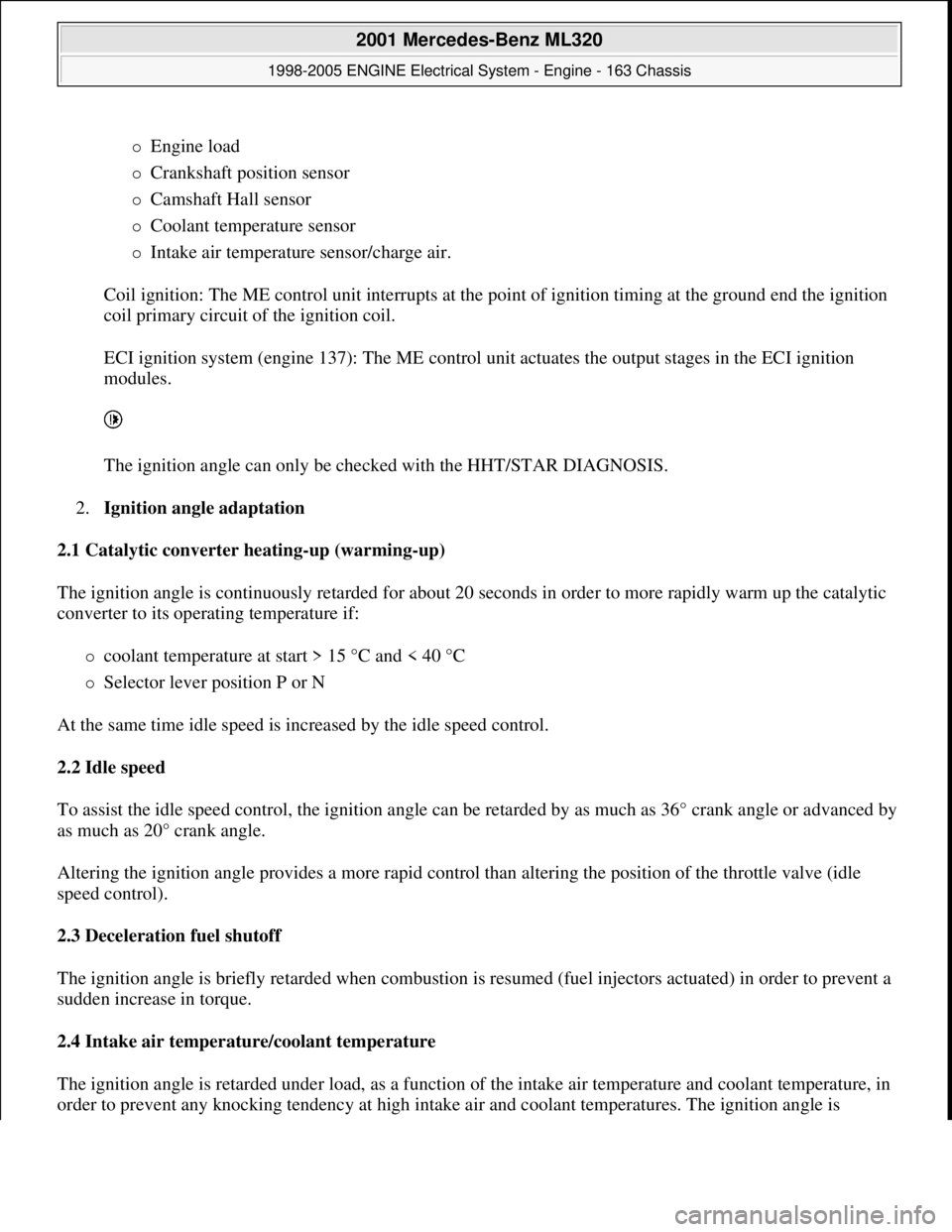
Engine load
Crankshaft position sensor
Camshaft Hall sensor
Coolant temperature sensor
Intake air temperature sensor/charge air.
Coil ignition: The ME control unit interrupts at the point of ignition timing at the ground end the ignition
coil primary circuit of the ignition coil.
ECI ignition system (engine 137): The ME control unit actuates the output stages in the ECI ignition
modules.
The ignition angle can only be checked with the HHT/STAR DIAGNOSIS.
2.Ignition angle adaptation
2.1 Catalytic converter heating-up (warming-up)
The ignition angle is continuously retarded for about 20 seconds in order to more rapidly warm up the catalytic
converter to its operating temperature if:
coolant temperature at start > 15 °C and < 40 °C
Selector lever position P or N
At the same time idle speed is increased by the idle speed control.
2.2 Idle speed
To assist the idle speed control, the ignition angle can be retarded by as much as 36° crank angle or advanced by
as much as 20° crank angle.
Altering the ignition angle provides a more rapid control than altering the position of the throttle valve (idle
speed control).
2.3 Deceleration fuel shutoff
The ignition angle is briefly retarded when combustion is resumed (fuel injectors actuated) in order to prevent a
sudden increase in torque.
2.4 Intake air temperature/coolant temperature
The ignition angle is retarded under load, as a function of the intake air temperature and coolant temperature, in
order to prevent an
y knocking tendency at high intake air and coolant temperatures. The ignition angle is
2001 Mercedes-Benz ML320
1998-2005 ENGINE Electrical System - Engine - 163 Chassis
me
Saturday, October 02, 2010 3:18:54 PMPage 17 © 2006 Mitchell Repair Information Company, LLC.
Page 2172 of 4133
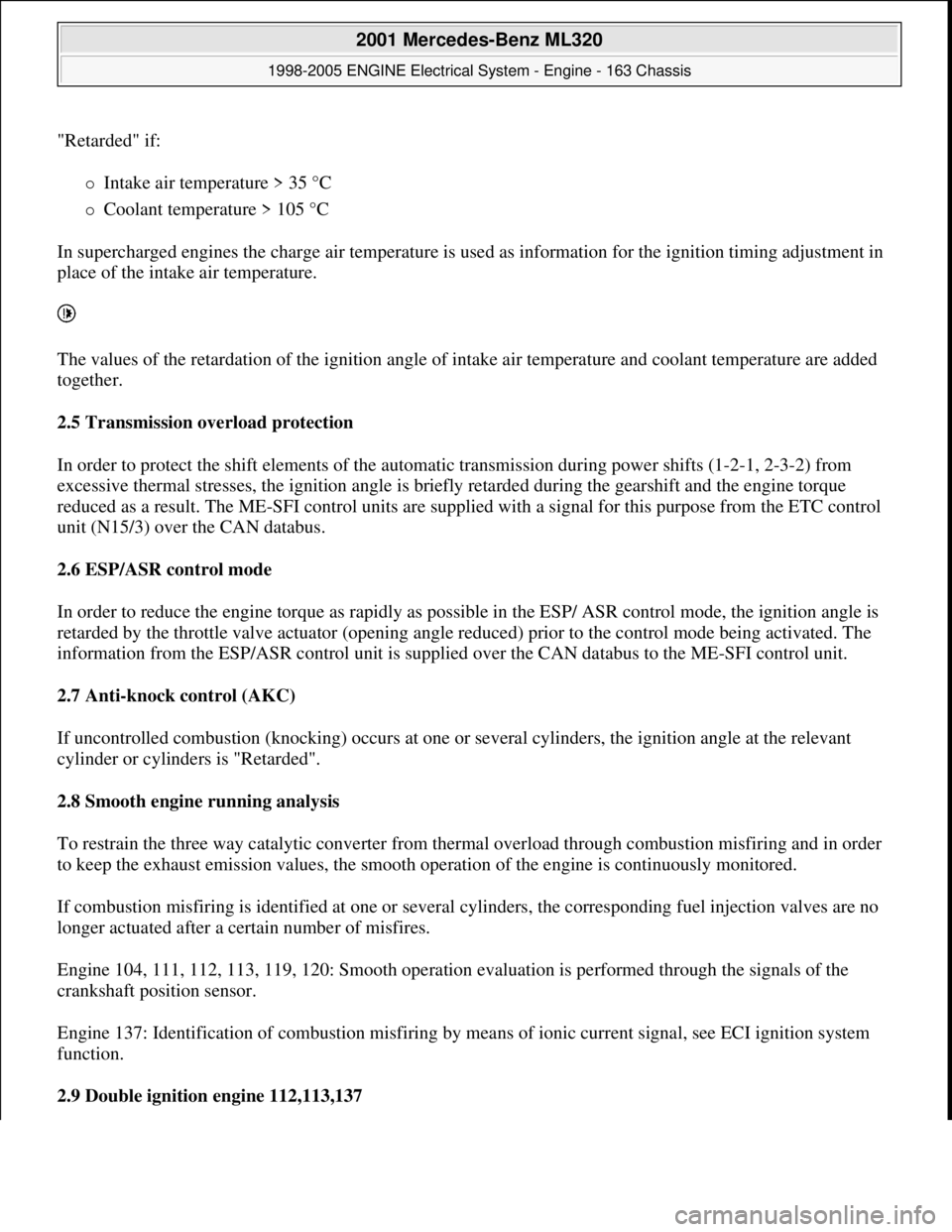
"Retarded" if:
Intake air temperature > 35 °C
Coolant temperature > 105 °C
In supercharged engines the charge air temperature is used as information for the ignition timing adjustment in
place of the intake air temperature.
The values of the retardation of the ignition angle of intake air temperature and coolant temperature are added
together.
2.5 Transmission overload protection
In order to protect the shift elements of the automatic transmission during power shifts (1-2-1, 2-3-2) from
excessive thermal stresses, the ignition angle is briefly retarded during the gearshift and the engine torque
reduced as a result. The ME-SFI control units are supplied with a signal for this purpose from the ETC control
unit (N15/3) over the CAN databus.
2.6 ESP/ASR control mode
In order to reduce the engine torque as rapidly as possible in the ESP/ ASR control mode, the ignition angle is
retarded by the throttle valve actuator (opening angle reduced) prior to the control mode being activated. The
information from the ESP/ASR control unit is supplied over the CAN databus to the ME-SFI control unit.
2.7 Anti-knock control (AKC)
If uncontrolled combustion (knocking) occurs at one or several cylinders, the ignition angle at the relevant
cylinder or cylinders is "Retarded".
2.8 Smooth engine running analysis
To restrain the three way catalytic converter from thermal overload through combustion misfiring and in order
to keep the exhaust emission values, the smooth operation of the engine is continuously monitored.
If combustion misfiring is identified at one or several cylinders, the corresponding fuel injection valves are no
longer actuated after a certain number of misfires.
Engine 104, 111, 112, 113, 119, 120: Smooth operation evaluation is performed through the signals of the
crankshaft position sensor.
Engine 137: Identification of combustion misfiring by means of ionic current signal, see ECI ignition system
function.
2.9 Double ignition engine 112,113,137
2001 Mercedes-Benz ML320
1998-2005 ENGINE Electrical System - Engine - 163 Chassis
me
Saturday, October 02, 2010 3:18:54 PMPage 18 © 2006 Mitchell Repair Information Company, LLC.
Page 2173 of 4133
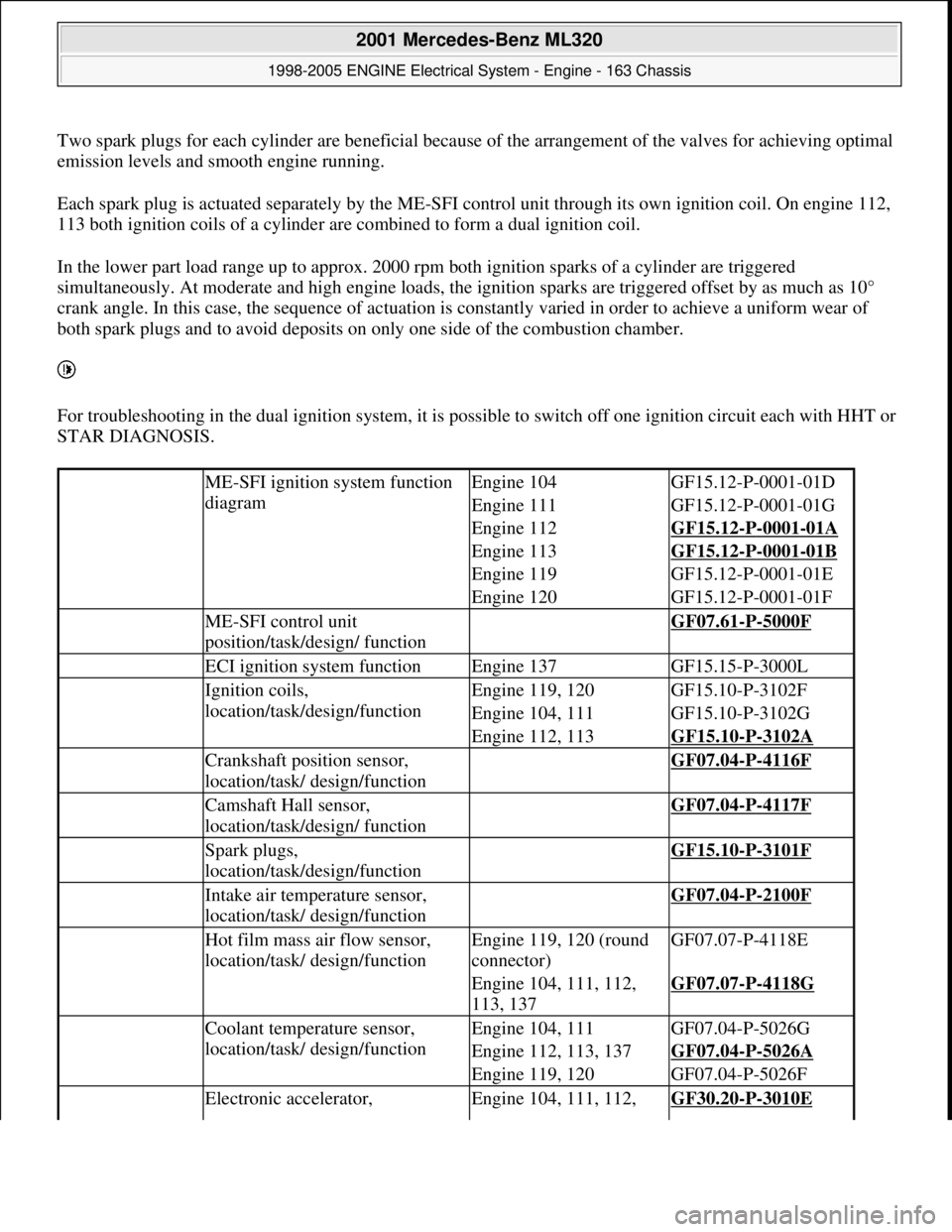
Two spark plugs for each cylinder are beneficial because of the arrangement of the valves for achieving optimal
emission levels and smooth engine running.
Each spark plug is actuated separately by the ME-SFI control unit through its own ignition coil. On engine 112,
113 both ignition coils of a cylinder are combined to form a dual ignition coil.
In the lower part load range up to approx. 2000 rpm both ignition sparks of a cylinder are triggered
simultaneously. At moderate and high engine loads, the ignition sparks are triggered offset by as much as 10°
crank angle. In this case, the sequence of actuation is constantly varied in order to achieve a uniform wear of
both spark plugs and to avoid deposits on only one side of the combustion chamber.
For troubleshooting in the dual ignition system, it is possible to switch off one ignition circuit each with HHT or
STAR DIAGNOSIS.
ME-SFI ignition system function
diagramEngine 104GF15.12-P-0001-01D
Engine 111GF15.12-P-0001-01G
Engine 112GF15.12-P-0001-01A
Engine 113GF15.12-P-0001-01B
Engine 119GF15.12-P-0001-01E
Engine 120GF15.12-P-0001-01F
ME-SFI control unit
position/task/design/ function GF07.61-P-5000F
ECI ignition system functionEngine 137GF15.15-P-3000L
Ignition coils,
location/task/design/functionEngine 119, 120GF15.10-P-3102F
Engine 104, 111GF15.10-P-3102G
Engine 112, 113GF15.10-P-3102A
Crankshaft position sensor,
location/task/ design/function GF07.04-P-4116F
Camshaft Hall sensor,
location/task/design/ function GF07.04-P-4117F
Spark plugs,
location/task/design/function GF15.10-P-3101F
Intake air temperature sensor,
location/task/ design/function GF07.04-P-2100F
Hot film mass air flow sensor,
location/task/ design/functionEngine 119, 120 (round
connector)GF07.07-P-4118E
Engine 104, 111, 112,
113, 137GF07.07-P-4118G
Coolant temperature sensor,
location/task/ design/functionEngine 104, 111GF07.04-P-5026G
Engine 112, 113, 137GF07.04-P-5026A
Engine 119, 120GF07.04-P-5026F
Electronic accelerator, Engine 104, 111, 112, GF30.20-P-3010E
2001 Mercedes-Benz ML320
1998-2005 ENGINE Electrical System - Engine - 163 Chassis
me
Saturday, October 02, 2010 3:18:54 PMPage 19 © 2006 Mitchell Repair Information Company, LLC.
Page 2177 of 4133
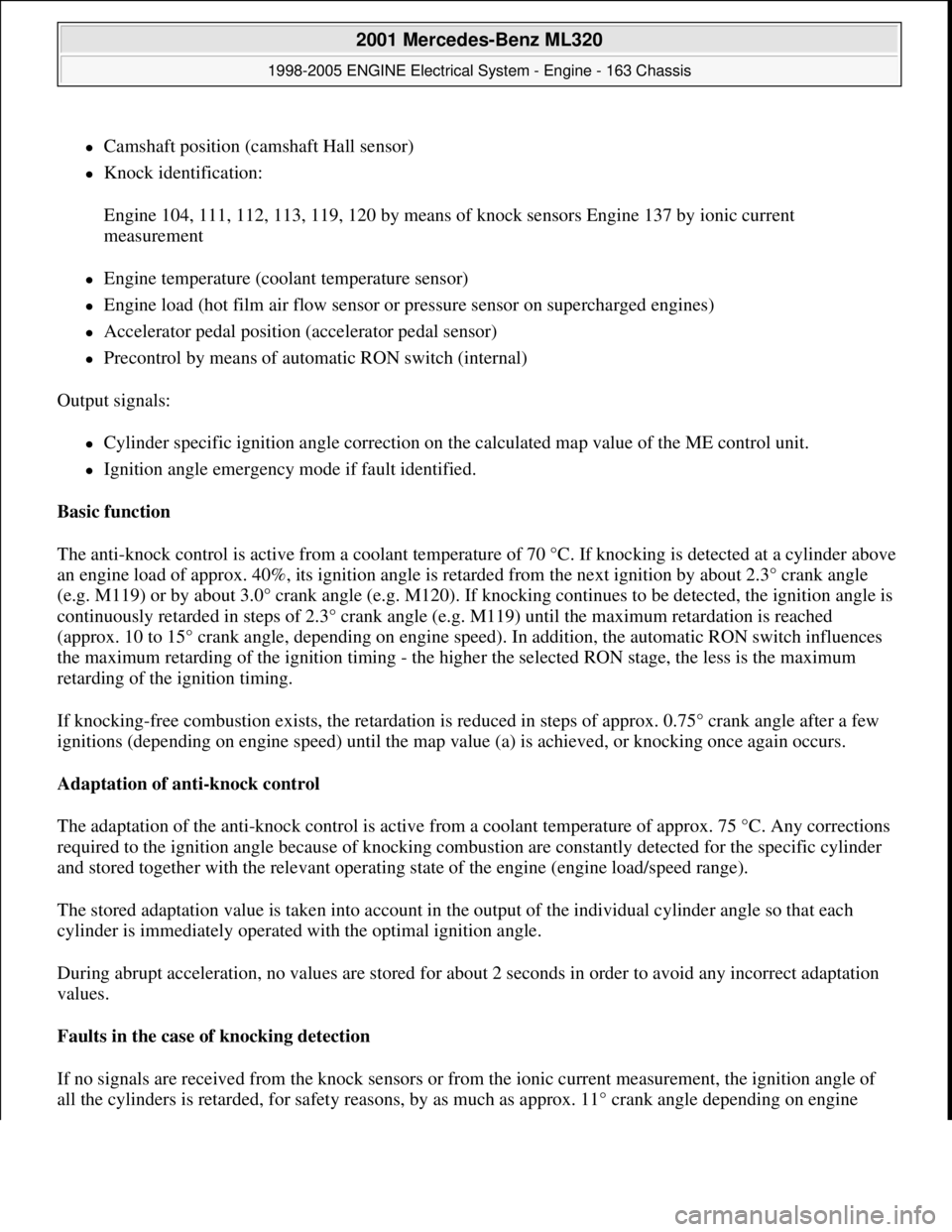
Camshaft position (camshaft Hall sensor)
Knock identification:
Engine 104, 111, 112, 113, 119, 120 by means of knock sensors Engine 137 by ionic current
measurement
Engine temperature (coolant temperature sensor)
Engine load (hot film air flow sensor or pressure sensor on supercharged engines)
Accelerator pedal position (accelerator pedal sensor)
Precontrol by means of automatic RON switch (internal)
Output signals:
Cylinder specific ignition angle correction on the calculated map value of the ME control unit.
Ignition angle emergency mode if fault identified.
Basic function
The anti-knock control is active from a coolant temperature of 70 °C. If knocking is detected at a cylinder above
an engine load of approx. 40%, its ignition angle is retarded from the next ignition by about 2.3° crank angle
(e.g. M119) or by about 3.0° crank angle (e.g. M120). If knocking continues to be detected, the ignition angle is
continuously retarded in steps of 2.3° crank angle (e.g. M119) until the maximum retardation is reached
(approx. 10 to 15° crank angle, depending on engine speed). In addition, the automatic RON switch influences
the maximum retarding of the ignition timing - the higher the selected RON stage, the less is the maximum
retarding of the ignition timing.
If knocking-free combustion exists, the retardation is reduced in steps of approx. 0.75° crank angle after a few
ignitions (depending on engine speed) until the map value (a) is achieved, or knocking once again occurs.
Adaptation of anti-knock control
The adaptation of the anti-knock control is active from a coolant temperature of approx. 75 °C. Any corrections
required to the ignition angle because of knocking combustion are constantly detected for the specific cylinder
and stored together with the relevant operating state of the engine (engine load/speed range).
The stored adaptation value is taken into account in the output of the individual cylinder angle so that each
cylinder is immediately operated with the optimal ignition angle.
During abrupt acceleration, no values are stored for about 2 seconds in order to avoid any incorrect adaptation
values.
Faults in the case of knocking detection
If no signals are received from the knock sensors or from the ionic current measurement, the ignition angle of
all the c
ylinders is retarded, for safety reasons, by as much as approx. 11° crank angle depending on engine
2001 Mercedes-Benz ML320
1998-2005 ENGINE Electrical System - Engine - 163 Chassis
me
Saturday, October 02, 2010 3:18:54 PMPage 23 © 2006 Mitchell Repair Information Company, LLC.
Page 2178 of 4133
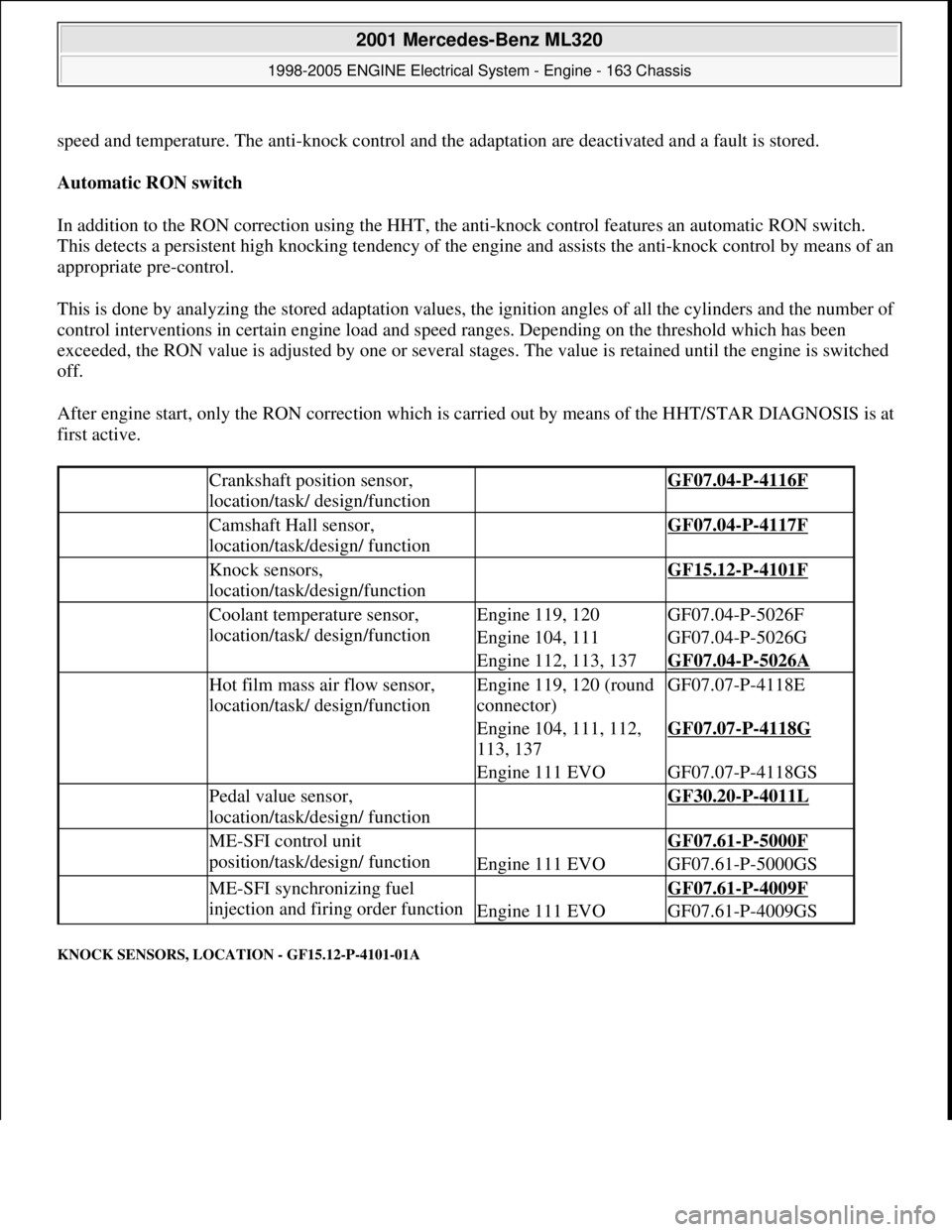
speed and temperature. The anti-knock control and the adaptation are deactivated and a fault is stored.
Automatic RON switch
In addition to the RON correction using the HHT, the anti-knock control features an automatic RON switch.
This detects a persistent high knocking tendency of the engine and assists the anti-knock control by means of an
appropriate pre-control.
This is done by analyzing the stored adaptation values, the ignition angles of all the cylinders and the number of
control interventions in certain engine load and speed ranges. Depending on the threshold which has been
exceeded, the RON value is adjusted by one or several stages. The value is retained until the engine is switched
off.
After engine start, only the RON correction which is carried out by means of the HHT/STAR DIAGNOSIS is at
first active.
KNOCK SENSORS, LOCATION - GF15.12-P-4101-01A
Crankshaft position sensor,
location/task/ design/function GF07.04-P-4116F
Camshaft Hall sensor,
location/task/design/ function GF07.04-P-4117F
Knock sensors,
location/task/design/function GF15.12-P-4101F
Coolant temperature sensor,
location/task/ design/functionEngine 119, 120GF07.04-P-5026F
Engine 104, 111GF07.04-P-5026G
Engine 112, 113, 137GF07.04-P-5026A
Hot film mass air flow sensor,
location/task/ design/functionEngine 119, 120 (round
connector)GF07.07-P-4118E
Engine 104, 111, 112,
113, 137GF07.07-P-4118G
Engine 111 EVOGF07.07-P-4118GS
Pedal value sensor,
location/task/design/ function GF30.20-P-4011L
ME-SFI control unit
position/task/design/ function GF07.61-P-5000F
Engine 111 EVOGF07.61-P-5000GS
ME-SFI synchronizing fuel
injection and firing order function GF07.61-P-4009F
Engine 111 EVOGF07.61-P-4009GS
2001 Mercedes-Benz ML320
1998-2005 ENGINE Electrical System - Engine - 163 Chassis
me
Saturday, October 02, 2010 3:18:54 PMPage 24 © 2006 Mitchell Repair Information Company, LLC.
Page 2380 of 4133

Fig. 15: Locating Casting Crust In Cooling Duct
COOLANT TEMPERATURE HIGHER THAN NORMAL - AF01.30-P-8000A
ENGINE 113.##### up to 286599 in MODEL 129, 163, 202, 208, 210, 215, 220
ENGINE 113.### ## up to 286599 in MODEL 463
Modification notes
17.1.01Supersedes STIP 20.10-004 dated 17.01.2001
Damage
codeCauseRemedy
01 243 B2
Cylinder head with
casting crust in
coolant duct
Before performing work on cooling system, coolant
pump, heater housing, etc.: ?
1. Remove left cylinder head
ENGINE 113 in MODEL 210, 208, 202, 129AR01.30-P-
5800B
ENGINE 113 in MODEL 220AR01.30-P-
5800BA
ENGINE 112.945, 113.962 in MODEL 463AR01.30-P-
5800GV
ENGINE 113.942 in MODEL 163.172AR01.30-P-
5800MV
ENGINE 113.981 in MODEL 163.174
2 Check coolant duct, if necessary, remove possible casting
crust As of engine end number (as of beginning of
01/2001) there is no casting crust at this point.
2001 Mercedes-Benz ML320
1998-2005 ENGINE Complete engine - 163 Chassis
me
Saturday, October 02, 2010 3:17:56 PMPage 24 © 2006 Mitchell Repair Information Company, LLC.
Page 2396 of 4133
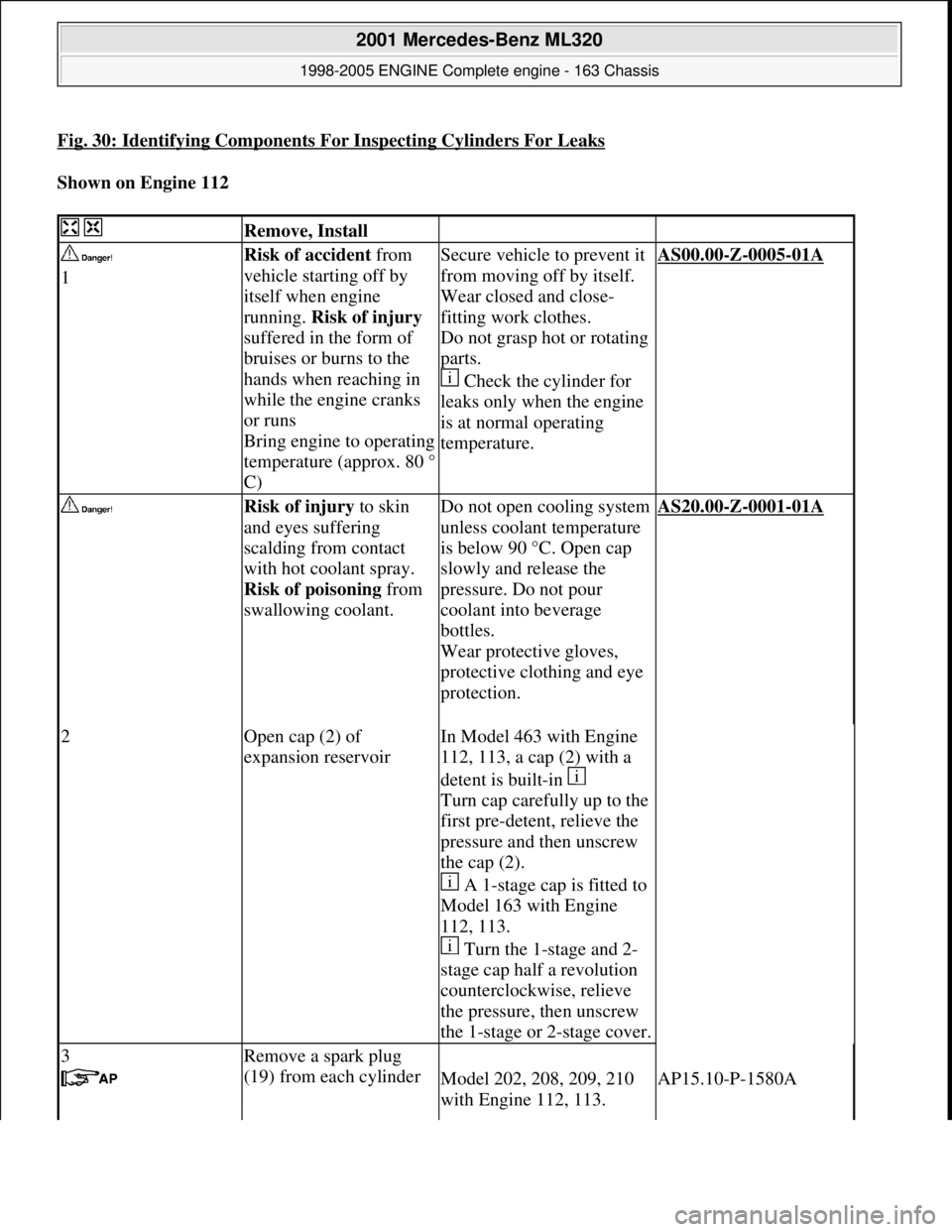
Fig. 30: Identifying Components For Inspecting Cylinders For Leaks
Shown on Engine 112
Remove, Install
1Risk of accident from
vehicle starting off by
itself when engine
running. Risk of injury
suffered in the form of
bruises or burns to the
hands when reaching in
while the engine cranks
or runs
Bring engine to operating
temperature (approx. 80 °
C)Secure vehicle to prevent it
from moving off by itself.
Wear closed and close-
fitting work clothes.
Do not grasp hot or rotating
parts.
Check the cylinder for
leaks only when the engine
is at normal operating
temperature.AS00.00-Z-0005-01A
Risk of injury to skin
and eyes suffering
scalding from contact
with hot coolant spray.
Risk of poisoning from
swallowing coolant.
Do not open cooling system
unless coolant temperature
is below 90 °C. Open cap
slowly and release the
pressure. Do not pour
coolant into beverage
bottles.
Wear protective gloves,
protective clothing and eye
protection.
AS20.00-Z-0001-01A
2Open cap (2) of
expansion reservoirIn Model 463 with Engine
112, 113, a cap (2) with a
detent is built-in
Turn cap carefully up to the
first pre-detent, relieve the
pressure and then unscrew
the cap (2).
A 1-stage cap is fitted to
Model 163 with Engine
112, 113.
Turn the 1-stage and 2-
stage cap half a revolution
counterclockwise, relieve
the pressure, then unscrew
the 1-stage or 2-stage cover.
3Remove a spark plug
(19) from each cylinder
Model 202, 208, 209, 210
with Engine 112, 113.AP15.10-P-1580A
2001 Mercedes-Benz ML320
1998-2005 ENGINE Complete engine - 163 Chassis
me
Saturday, October 02, 2010 3:17:56 PMPage 40 © 2006 Mitchell Repair Information Company, LLC.